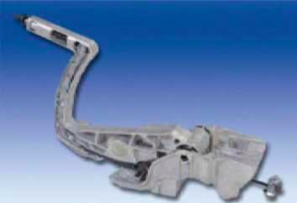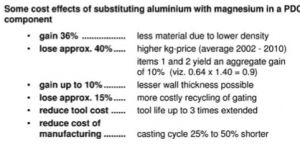By Dr. Andreas Waldraff*
 * The author is CEO of UBF.B Management Consultancy, a service company with its focus on the automotive industry and Indo-German business. Its has offices in Berlin, Chennai, Pune and Stuttgart. For details, contact: andreas.waldraff@ubfb.de.
* The author is CEO of UBF.B Management Consultancy, a service company with its focus on the automotive industry and Indo-German business. Its has offices in Berlin, Chennai, Pune and Stuttgart. For details, contact: andreas.waldraff@ubfb.de.
Volkswagen’s beetle, produced more than 21 million times from 1938 until 2003, already contained a lot of magnesium – engine block, gearbox housing and other components – in order to save weight. The vehicle’s promoters were concerned about a sufficient mileage and, challenged by the rear-mounted engine, a well balanced structure. Eventually, the car made 14 km to the litre. Its net weight was approximately 600 kg: without magnesium the weight would have been 50 kg more and mileage five-eight per cent less.
Peak annual consumption of the magic material for this car has been 42,000 tons in 1971. When its air-cooled engine was substituted by a liquid-cooled one, the magnesium-made engine block had to be substituted and consumption dropped. Corrosion from contact with water was one of magnesium’s critical weaknesses before modern alloys had been developed.
A vehicle’s mileage is affected by many factors: structural weight, air resistance, way of driving, road pattern, number of passengers and load, efficiency of driveline, usage of AC, recuperation of kinetic energy, quality of tyres, and so on. In urban low-speed stop-and-go traffic the largest part of energy is consumed in bringing the vehicle up to whatever little speed after every stop. This is the mobility pattern today of the majority of Indian vehicles. Over and over again the mass of e.g., a passenger car is accelerated and, shortly after, brought to a stop again: fossile energy first transformed into kinetic energy and then (mis)used to heat the brake discs. In this type of traffic a vehicle’s mass is key to fuel consumption. Slightly overstating the effects one can say that 10 per cent less weight will improve the mileage by 10 per cent.
 From a design point of view weight reduction opens the door to a highly attractive feed-back cycle. Less structural weight will, other things remaining equal, allow to use e.g., a smaller engine or brake system which in turn allows a lighter structure. The “down-sizing” spiral will be a dominant theme for the future for better mileage, less CO2 and improved dynamics. Audi’s CEO lately has asked for “most aggressive light-weight design”.
From a design point of view weight reduction opens the door to a highly attractive feed-back cycle. Less structural weight will, other things remaining equal, allow to use e.g., a smaller engine or brake system which in turn allows a lighter structure. The “down-sizing” spiral will be a dominant theme for the future for better mileage, less CO2 and improved dynamics. Audi’s CEO lately has asked for “most aggressive light-weight design”.
In the context of commercial vehicles one kg saved in structural weight is one kg gained in payload. The CO2 targets set by the European Union as per 2015 will demand a serious slimming diet. It is safe to assume that today not many new specification sheets are released to the design engineers without prescribing a massive weight reduction. And the necessities of electrically driven vehicles will very soon accelerate this trend.
Magnesium is a powerful, well explored option to reduce weight. The metal is very light, 36 per cent lighter than aluminium, the other widely used non-ferrous metal in the automotive industry, and 78 per cent lighter than steel. Its mechanical properties cover much the same spectrum as aluminium. Experts believe that a modern car may well take 50 to 80 kg of the metal to be used in motor blocks, gearbox housings, door panels, door locking devices, mirrors, tailgates, steering wheels, consoles and else.
The German Fraunhofer Institute for Machine Tools and Forming Technology IWU, Chemnitz, has designed a car door weighing 4.7 kg (steel: 10.7 kg). Advanced applications are magnesium foam parts or composite materials using magnesium and e.g., aluminium together. Other usages in laptops, cameras, mobile phones and medical instruments should be mentioned for the sake of completeness. Here, the excellent dampening properties regarding sound and electromagnetic waves are highly welcomed advantages of the metal.
 In some applications the inferior thermal stability and conductivity of magnesium compared to aluminium may be a drawback. Also, aluminium tends to be more resistant to corrosion. When used for exterior parts magnesium usually requires special coating. Forging is weak spot: only few magnesium alloys can be forged. So, just as for every other material, there is a generic frame of properties within which the great advantages of magnesium can be exploited.
In some applications the inferior thermal stability and conductivity of magnesium compared to aluminium may be a drawback. Also, aluminium tends to be more resistant to corrosion. When used for exterior parts magnesium usually requires special coating. Forging is weak spot: only few magnesium alloys can be forged. So, just as for every other material, there is a generic frame of properties within which the great advantages of magnesium can be exploited.
For a given structure and a realistic production volume probably a mix of advanced materials will yield best results. A European project jointly run by Daimler, Fiat, Opel, Porsche, Renault, Volvo and Volkswagen has made proposals for a Super Light Car (SLC). Its body uses a blend of materials and consists of aluminium (53 per cent), steel (36 per cent), magnesium (7 per cent), and plastics (4 per cent). Compared to the conventional reference body the weight reduction has been 35 per cent.
In automotive applications today pressure die-casting (PDC) is the widest spread technology for magnesium-made components. Due to its superior flow-characteristics magnesium will allow very fine structures with a wall thickness of below one millimetre. This gives greater freedom to tool design and permits further weight reduction when thick walls are not really required for e.g., stability or heat transfer. Lower risk of porosity is another advantage of magnesium PDC parts. The better flow properties of magnesium allow to push the lifetime of a PDC-tool from, say, one lakh shots to three lakh shots which can be a significant cost saving in mass production. Further savings may arise out of shorter cycle times in the casting process.
 But is it not very expensive? No, not when one compares apples to apples. On a per volume basis, magnesium tends to be even cheaper than aluminium. As a component will not normally change its basic geometry when made of magnesium rather than aluminium, the more appropriate basis for comparison is a per-litre price. On this basis magnesium has actually been cheaper in the past than aluminium. For the years 2002 to 2010 the metal has been on an average 40 per cent more expensive than aluminium on a per-kg basis but 10 per cent cheaper on a per-litre basis. During the initial years of building up a magnesium industry in India the access to a recycling facility will be a particular issue and cost factor.
But is it not very expensive? No, not when one compares apples to apples. On a per volume basis, magnesium tends to be even cheaper than aluminium. As a component will not normally change its basic geometry when made of magnesium rather than aluminium, the more appropriate basis for comparison is a per-litre price. On this basis magnesium has actually been cheaper in the past than aluminium. For the years 2002 to 2010 the metal has been on an average 40 per cent more expensive than aluminium on a per-kg basis but 10 per cent cheaper on a per-litre basis. During the initial years of building up a magnesium industry in India the access to a recycling facility will be a particular issue and cost factor.
Whether, from a point of view of total cost, magnesium is the better material for a given part is not easy to assess. One will have to analyse and compare factors such as the basic feasibility of magnesium in a given product environment, typical usage patterns, production volumes, and the remaining life time of a component in the life cycle of the final product.
In some instances the weight reduction is honoured by the receiving OEM with a substantial bonus of several dollars per kg saved. In addition, one should assess the reduced fuel consumption during the lifetime of the product. For a reasonably comprehensive analysis one has to integrate at least the factors which are indicated in the accompanying box.
A promising starting point for India’s vehicle manufacturers could be the two side plates of the 10 millions of 2-wheelers that are produced every year – today mostly made of aluminium and clearly offering better mileage on a large scale if made of magnesium.